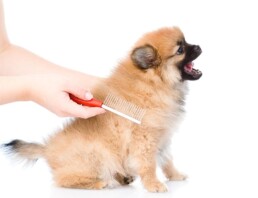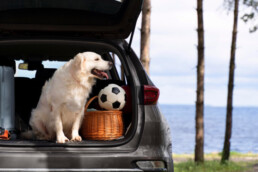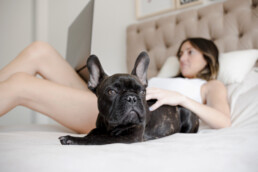Dog shedding

A dog coat consists of two layers: top coat (jar) and undercoat (wad). The jar hair is longer, stiff and scratchy and provide protection against environmental agents. The undercoat or wad consists of a fluffy and short layer which protects and isolate the dog from external air. However, the wad is not present in all breeds, but it is very important in Nordic breeds. The coat softness depends on the hair thickness, that means on the number of follicles per square centimeter of skin. This number is determined at birth and it is closely related to breed and age. In fact, puppies have a softer coat because it only consists of undercoat.
In Spring, when the weather changes, the dog is subject to a significant hair loss, which is generally called shedding. In fact, hair doesn’t last for ever and there is a cyclical activity which involves hair production and loss during shedding, generally taking place twice a year. As it happens for wild animals, even dogs have a summer coat and a coat suitable for wintertime, which is much more abundant compared to the summer coat, in order to protect them during the cold period.
Shedding varies in intensity and duration according to breed and to dog’s lifestyle. In any case, hair does not fall all at once, but gradually from the animal’s rear to the front. The main factor that determines the beginning of the shedding is the photoperiod, that is the duration of light hours compared to darkness. In Spring the duration of light hours is longer and triggers the shedding onset. For this reason a dog that lives in the garden will have a more regular and shorter shedding compared to dogs living in a flat. The change in temperature affects the density and the hair renewal speed, but it is not the factor that triggers the shedding.
Thus in Spring it is very important to brush more or less frequently the dog according to the type of hair to avoid the formation of hair snarls which might create an anti-aesthetic, sometimes annoying and painful effect. In case of close-cropped dogs, a constant care is not required: it is enough to brush them 1-2 times a week. By passing with a stiff brush in the opposite direction of hair growth, dandruff and dead hair will be detached and afterwards they can then be removed by using a bristle brush passed in the direction of hair growth. In case of short hair, since it is very dense and hard, the dog should be brushed every two days. Also in this case first brush in the opposite direction of hair growth with a carder to remove hair, desquamated cells and to reduce the undercoat, then a bristle brush must be used in the direction of hair growth to remove all residues. For long hair a daily brushing is required in the direction of hair growth. Use a brush that allows to undo the knots and to remove the undercoat gently to avoid hurting the dog. A bristle brush makes the coat shining while the wire brush is useful to remove impurities.
An alternative to frequent brushing is to turn to professional groomers for specialized treatments, indispensable for certain breeds.
Share
Related posts
Holiday with 4-leggend friends
What measures should you take to plan a top holiday with your…
Can we pass the stress on to our dog?
According to a study conducted by Linköping University in…

